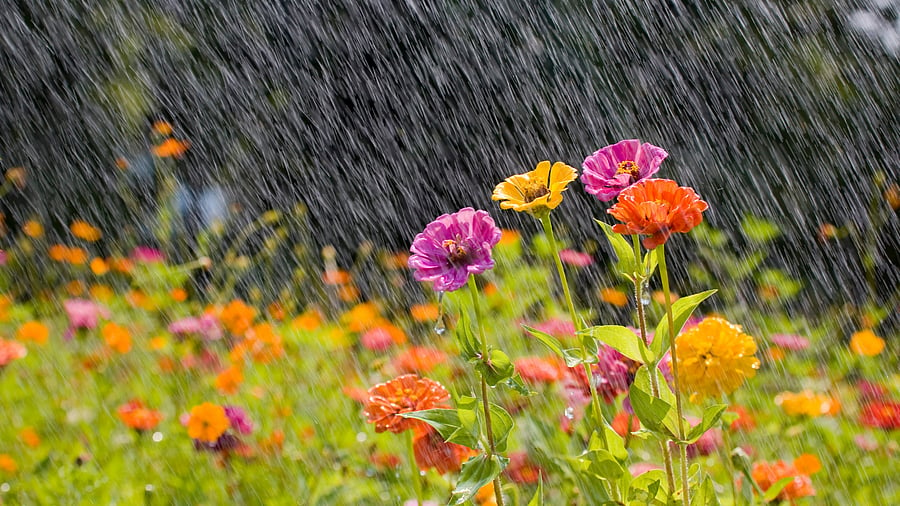
How do you know when the season is about to change? Across days and seasons in my garden, I’ve learned the answer: the garden always knows first. Quiet signals appear long before any forecast does.
The call of a deep-throated koel tears through the cool summer morning air, followed by the distant barbets. A few moments later, the ghoom-ghoom sound of the crow pheasant echoes through the garden. The songs of other passerine birds join the chorus, each one saying something we humans cannot quite understand. But we know they arrive in season, like the Tickell’s Blue Flycatcher. Its soft tinkling melody drifts down from the palms, as it comes to feast on the bees busy with the butterfly palm flowers.
The faint scent of ripe mangoes drifts in from elsewhere in the garden. We gathered a basketful yesterday. Among them were a few fruits, partially pecked by birds. These are always the sweetest, because the birds choose only the best. The birds are the first to open a ripe fruit. When they are done, the squirrels, butterflies, and bees take over, and the fruit soon falls, with a little pulp still clinging to it. The squirrels do not eat the fruits that have fallen. The bees and flies soon descend on the fruit, and the bees never seem to have enough. They cling to the mangoes as though intoxicated. When I tried to shake them off, the flies scattered, but the bees held fast, one or two staggered tipsily on the ground before settling back for another sip. This year, the mangoes have been remarkably sweet. Perhaps that explains the unusually large number of bees in the garden.
The winter and spring flowers have shed their blooms and turned green. The rhizomes — turmeric, ginger, and yam — are flush with leaves, ready to channel the rain to feed the swelling roots beneath. Pink flowers of black turmeric pop up to mark this turning of the season.
Now is the time to prepare. I remind myself to add a layer of homemade compost to the beds before the monsoon sets in properly. I’ve also grown coriander, methi, and gourd seedlings, which look fresh and ready for the season ahead.
The ants, so active all through summer, have begun shifting their nests to dry spots. Empty pots in the shade become their safe shelters. When the ants start moving, you can feel the change in humidity in the air. This is a sure sign that rain is near. After the first few spells of rain, the earthworms surface. During the dry season, they burrow deeper, where some moisture remains. The first rains soften the surface, and the worms rise, only to burrow again into the refreshed earth.
Spores in the soil will stir. Tiny mushrooms, no larger than a coin, will pop up overnight on the lawn and in pots. The rain lilies will bloom as if by magic with the first showers. It doesn’t matter how much you water throughout the year; they appear only after the touch of true rain.
Once the monsoon settles in, swarms of dragonflies and mayflies arrive. The mayflies cluster near lamps and lighted windows, while dragonflies dart across the garden, hunting mosquitoes that have increased after the rain. By then, some of those dropped mango seeds will already have begun to sprout in unexpected corners of the garden.
The garden will seem prepared for the next chain of transformations, almost expectant, feeling meditative as it quietly absorbs the moment.
These small signals remind me once again that the garden is a better forecaster than any scientist. And no two years are ever the same, but there is always something new to notice.
Motley Garden is your monthly kaleidoscopic view into a sustainable garden ecosystem. The author believes gardens are shared spaces where plants and creatures thrive together.
READER’S QUERY
Can you guide me about the indigenous plants one can grow in pots on a terrace garden?
Saraswathi
For terrace pots, I recommend these reliable performers: Crossandra (Kanakambara) and crepe jasmine (Nandi Batlu) bloom year-round in medium pots, and butterfly pea (Shankhapushpi) works as a climbing annual. Although parijatha, Cassia auriculata and Wrightia tinctoria are big plants, they can thrive in large containers. Among herbs, tulsi, curry leaf, doddapatre, and lemongrass adapt beautifully to pot culture. These plants have flourished in our local conditions for generations and will give your terrace an authentic regional character.
Write in with your garden queries and stories at allthingsinmygarden@gmail.com